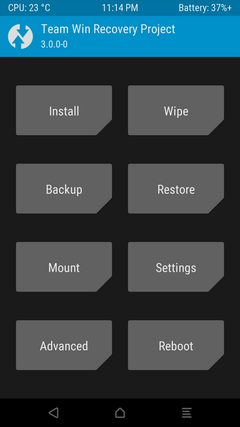Team Win Recovery Project
 Main screen of TWRP 3.0.0-0 | |
| Developer(s) | TeamWin |
|---|---|
| Initial release | 30 July 2011[1] |
| Stable release |
3.2.3-0
/ 6 August 2018[2] |
| Written in | C++ |
| Operating system | Android |
| Available in | English |
| License | GNU General Public License v3[3] |
| Website |
twrp |
| As of | April 2016 |
Team Win Recovery Project (TWRP) is an open-source software custom recovery image for Android-based devices.[4][5] It provides a touchscreen-enabled interface with partial material design that allows users to install third-party firmware and back up the current system which are functions often unsupported by stock recovery images.[5][6][7][8] It is, therefore, often installed when flashing, installing or rooting Android devices,[9] although it isn't dependent on a device being rooted to be installed.
Functions
Since February 2016 the first three digits of the version number specify the version, and the fourth digit, separated from the others by a dash, specifies an update for a specific device. This could be a performance improvement or a bugfix.
As of 2017 it was the most widespread custom recovery.[10] The main method of installing, or "flashing", this custom recovery on an Android device requires downloading a version made specifically for the device, and then using a tool such as fastboot, ODIN or Heimdall for Samsung devices, on a PC to replace the stock recovery image with the TWRP one. Also, some custom ROMs come with TWRP as the default recovery.
TWRP gives users the option to fully back up their device (including boot, system, etc.) to revert to at any time, and a built-in file manager to delete files that may be causing problems on the device or add some to fix issues.
As of 2017 TWRP supported the installation of custom ROMs, kernels, add-ons (e.g. Google Apps, SuperSU, Themes), and other various mods.
Wiping, backing up, restoring and mounting various device partitions (e.g. system, boot, userdata, cache and internal storage) are also supported. TWRP also features file transfer by MTP, a basic file manager and a terminal emulator. It is fully themeable.
In January 2017 the TWRP team released an Android application[11] that allows flashing the recovery using root access; however, unlike the recovery, the app is not open source. This app is also shipped via the official TWRP images to rooted and non-rooted devices. It is installed as a system-level app by default, making it unremovable from within the OS without root access.[12]
See also
- ClockworkMod recovery – an alternative to TWRP custom recovery.
References
- ↑ "TWRP 1.x". TeamWin. Retrieved 20 April 2014.
- ↑ "TWRP 3.2.2-0 Released". TeamWin. Retrieved 25 July 2018.
- ↑ "Team Win Recovery-Project". GitHub. 23 June 2017.
Core recovery files for the Team Win Recovery Project (T.W.R.P) - this is not up to date, please see
github.com /omnirom /android _bootable _recovery /
teamw.in /project /twrp2 - ↑ "TWRP". TeamWin. Retrieved 7 February 2016.
- 1 2 Haroon Q Raja (4 May 2013). "What Is TWRP Recovery & How To Install & Use It On Android Devices". AddictiveTips.
- ↑ Terrence O'Brien (20 December 2011). "Team Win Recovery Project 2.0 goes gold, tells your volume rocker to kiss off". Engadget.
- ↑ Danny Stieben (12 January 2014). "What's a Custom Recovery? Exploring CWM, TWRP, and Friends". MakeUseOf.
- ↑ Will Verduzco (10 April 2012). "Team Win Recovery Project Updated to 2.1". XDA Developers.
- ↑ Scott Matteson (31 March 2014). "Rooting your Kindle Fire: a cautionary tale concluded". TechRepublic.
- ↑ "iRoot APK Download Latest Version Free For Android". Retrieved 15 Oct 2017.
- ↑ Official TWRP App
- ↑ TWRP App installation screen
External links